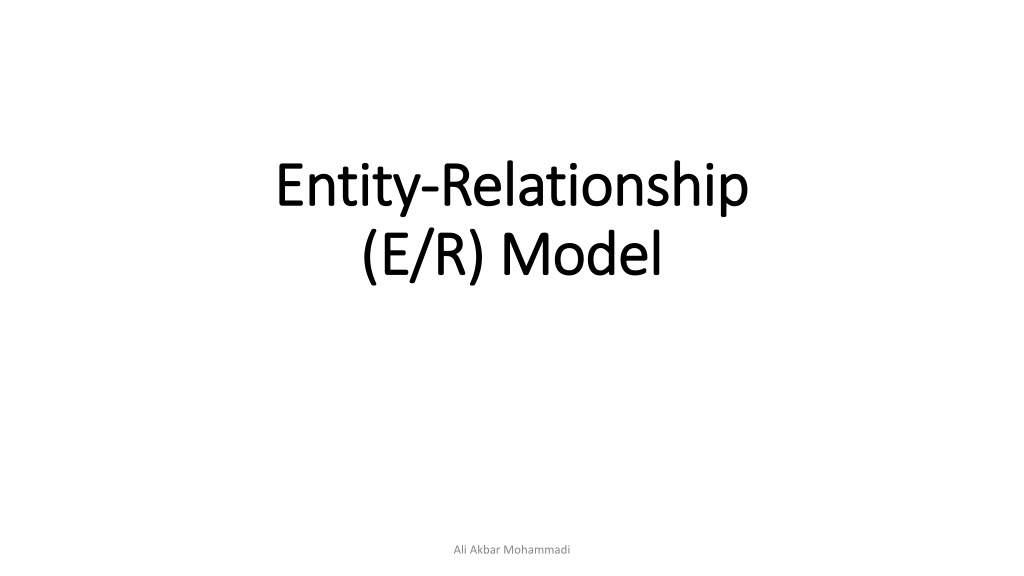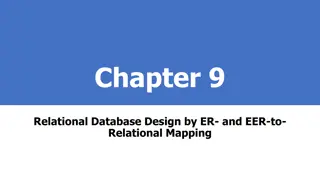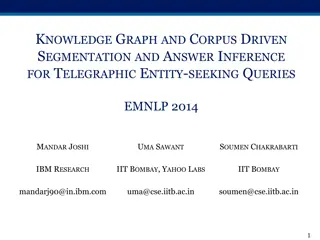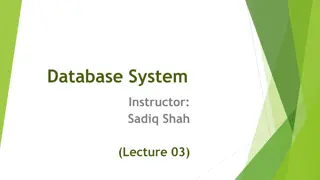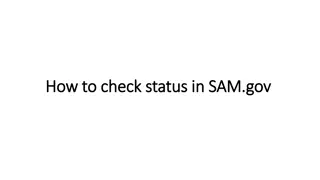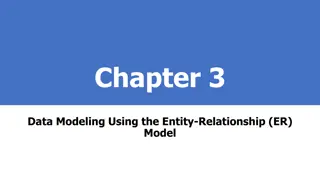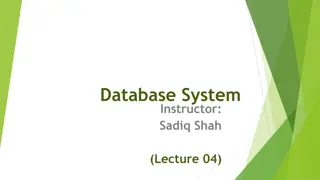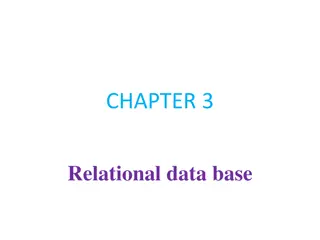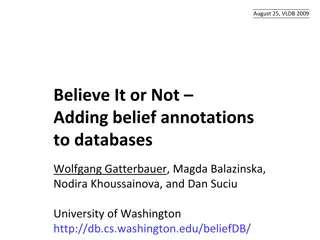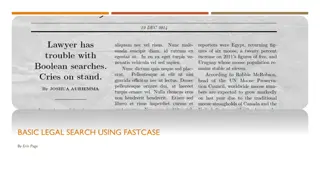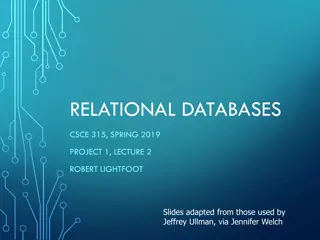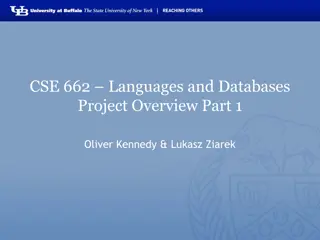Understanding Entity-Relationship Model in Databases
The Entity-Relationship Model (E/R Model) is a widely used conceptual data model proposed by Peter P. Chen. It provides a high-level description of the database system during the requirements collection stage. Entities represent things of independent existence, each described by a set of attributes. Attributes can be simple, composite, or derived, and can be single-valued or multi-valued. This model is essential in database design and is easy to understand for managers while being rigorous enough for system building.
Download Presentation

Please find below an Image/Link to download the presentation.
The content on the website is provided AS IS for your information and personal use only. It may not be sold, licensed, or shared on other websites without obtaining consent from the author. Download presentation by click this link. If you encounter any issues during the download, it is possible that the publisher has removed the file from their server.
E N D
Presentation Transcript
Entity Entity- -Relationship Relationship (E/R) Model (E/R) Model Ali Akbar Mohammadi
Entity Entity- -Relationship (E/R) Model Relationship (E/R) Model Widely used conceptual level data model Proposed by Peter P Chen in 1970s Data model to describe the database system at the requirements collection stage High level description. Easy to understand for the enterprise managers. Rigorous enough to be used for system building. Concepts available in the model Entities and attributes of entities. Relationships between entities. Diagrammatic notation. Ali Akbar Mohammadi 2
Entities Entities Entity: A thing (animate or inanimate) of independent physical or conceptual existence and distinguishable. For example in the University database context, an individual student, faculty member, a class room, a course are entities. Ali Akbar Mohammadi 3
Entity Set or Entity Type Entity Set or Entity Type Collection of entities all having the same properties. Student entity set collection of all student entities. Course entity set collection of all course entities. Ali Akbar Mohammadi 4
Attributes Attributes Each entity is described by a set of attributes/properties. student entity StudName name of the student. RollNumber the roll number of the student. Sex the gender of the student etc. All entities in an Entity set/type have the same set of attributes. Chosen set of attributes amount of detail in modeling. Ali Akbar Mohammadi 5
Types of Attributes (1/2) Types of Attributes (1/2) Simple Attributes Having atomic or indivisible values. example: Dept a string PhoneNumber an eight digit number Composite Attributes Having several components in the value. example: Qualification with components (DegreeName, Year, UniversityName) Derived Attributes Attribute value is dependent on some other attribute. example:Agedepends on DateOfBirth. So age is a derived attribute. Ali Akbar Mohammadi 6
Types of Attributes (2/2) Types of Attributes (2/2) Single-valued having only one value rather than a set of values. for instance, PlaceOfBirth single string value. Multi-valued having a set of values rather than a single value. for instance, CoursesEnrolled attribute for studentEmailAddress attribute for studentPreviousDegree attribute for student. Attributes can be: simple single-valued, simple multi-valued, composite single-valued or composite multi-valued. Ali Akbar Mohammadi 7
Diagrammatic Notation for Entities Diagrammatic Notation for Entities entity -rectangle attribute -ellipse connected to rectangle multi-valued attribute -double ellipse composite attribute -ellipse connected to ellipse derived attribute-dashed ellipse Ali Akbar Mohammadi 8
Diagrammatic Notation for Entities Diagrammatic Notation for Entities Ali Akbar Mohammadi 9
Domains of Attributes Domains of Attributes Each attribute takes values from a set called its domain For instance, studentAge {17,18, , 55} HomeAddress character strings of length 35 Domain of composite attributes cross product of domains of component attributes Domain of multi-valued attributes set of subsets of values from the basic domain Ali Akbar Mohammadi 10
Entity Sets and Key Attributes Entity Sets and Key Attributes Key an attribute or a collection of attributes whose value(s) uniquely identify an entity in the entity set. For instance, RollNumber-Key for Student entity set EmpID-Key for Faculty entity set HostelName, RoomNo-Key for Student entity set(assuming that each student gets to stay in a single room) A key for an entity set may have more than one attribute. An entity set may have more than one key. Keys can be determined only from the meaning of the attributes in the entity type. Determined by the designers Ali Akbar Mohammadi 11
Relationships Relationships When two or more entities are associated with each other, we have an instance of a Relationship. E.g.: student Ali enrolls in Discrete Mathematics course Relationship enrolls has Student and Course as the participating entity sets. Formally, enrolls Student Course (s,c) enrolls Student s has enrolled in Course c Tuples in enrolls relationship instances Enrolls is called a relationship Type/Set. Ali Akbar Mohammadi 12
Degree of a Relationship Degree of a Relationship Degree: the number of participating entities. Degree 2: binary Degree 3: ternary Degree n: n-ary Binary relationships are very common and widely used Ali Akbar Mohammadi 13
Diagrammatic Notation for Relationships Diagrammatic Notation for Relationships Relationship diamond shaped box Rectangle of each participating entity is connected by a line to this diamond. Name of the relationship is written in the box. Ali Akbar Mohammadi 14
Binary Relationships and Cardinality Ratio Binary Relationships and Cardinality Ratio The number of entities from E2 that an entity from E1 can possibly be associated thru R(and vice-versa) determines the cardinality ratio of R. Four possibilities are usually specified: one-to-one (1:1) one-to-many (1:N) many-to-one (N:1) many-to-many (M:N) Ali Akbar Mohammadi 15
Cardinality Ratios Cardinality Ratios One-to-one: One-to-many: Many-to-one: Many-to-many: An E1 entity may be associated with at most one E2entity and similarly an E2 entity may be associated with at most one E1entity. An E1entity may be associated with many E2entities whereas an E2entity may be associated with at most one E1 entity. ( similar to above) Many E1 entities may be associated with a single E2entity and a single E1entity may be associated with many E2entities. Ali Akbar Mohammadi 16
Cardinality Ratio Cardinality Ratio example (one example (one- -to to- -one) one) Ali Akbar Mohammadi 17
Cardinality Ratio Cardinality Ratio example (many to to- -many) many) example (many- -to to- -one/one one/one- - Ali Akbar Mohammadi 18
Cardinality Ratio Cardinality Ratio example (many example (many- -to to- -many) many) Ali Akbar Mohammadi 19
Participation Constraints Participation Constraints An entity set may participate in a relation either totally or partially. Total participation: Every entity in the set is involved in some association (or tuple) of the relationship. Partial participation: Not all entities in the set are involved in association (or tuples) of the relationship. Notation: Ali Akbar Mohammadi 20
Example of total/partial Participation Example of total/partial Participation Ali Akbar Mohammadi 21
